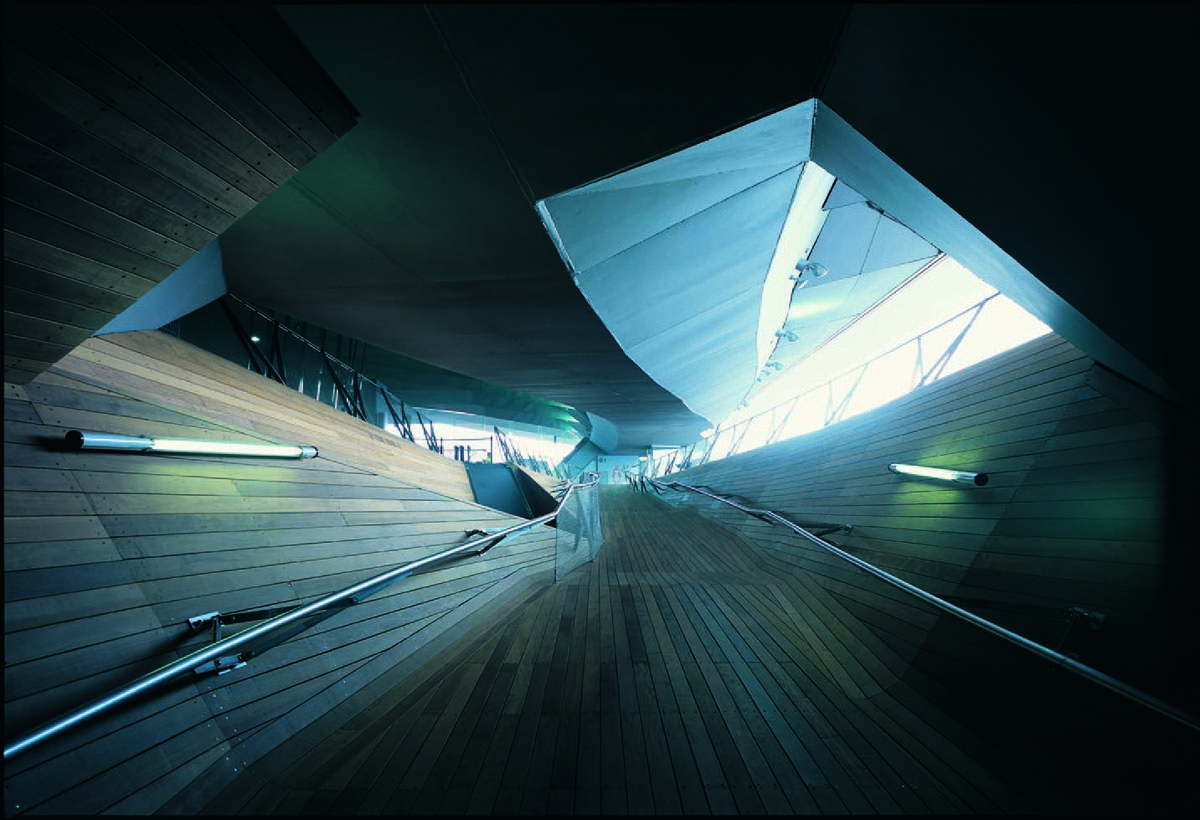|
© Satoru Mishima / FOA
| 横滨国际客运中心的接待处是整个项目最重要的组成部分,其设计充满了创造性的建筑方法和社会意识的思考,由Foreign Office Architects (FOA)事务所于1995年设计。充满未来感的客运中心体现了交通基础设施建设的新类型。其前卫、高科技的设计探索了建筑形式的新前沿,同时引发了对大型项目之于丰富城市公共空间的社会责任的激烈讨论。
The triumphant critical reception of the Yokohama International Passenger Terminal was the product of inventive architectural methodology and socially conscious thinking. Designed by Foreign Office Architects (FOA) in 1995, the futuristic terminal represented an emergent typology of transportation infrastructure. Its radical, hyper-technological design explored new frontiers of architectural form and simultaneously provoked a powerful discourse on the social responsibility of large-scale projects to enrich shared urban spaces.
| |
© Satoru Mishima / FOA
| 客运中心建筑方案的竞赛竞争非常激烈,Farshid Moussavi 和 Alejandro Zaera-Polo夫妻搭档的设计团队想要赢得这个项目需要对传统客运中心设计的既有模板进行重新思考。项目所在地是日本第二大城市的重要海滨,高昂的报酬吸引了来自全世界的660个参赛单位,是日本国内截至当时最大的国际竞赛。[1]这个巨大的430米长的项目耗时8年完成,总预算1.5亿英镑,项目设计期间要求FOA事务所临时搬迁到横滨指导施工。客运中心于2002年向公众开放,正好与在沿海岸线数英里之外举办的世界杯决赛不谋而合。
The architectural competition for the terminal was famously intense, and winning it required the then-wife-and-husband team of Farshid Moussavi and Alejandro Zaera-Polo to rethink the established template of terminal design. Located on an important waterfront site in Japan’s second most populous city, the high-profile commission attracted 660 entries from around the world, the country’s largest international competition to date. [1] The enormous, 430 meter-long project took eight years and a budget of £150 million to complete, and required FOA to temporarily relocate their studios to Yokohama to supervise construction. The public opening of the terminal occurred in 2002, serendipitously coinciding with the final game of the World Cup being held only a few miles from the shoreline.
| |

© Satoru Mishima / FOA
© Satoru Mishima / FOA
| 有赖于计算机设计技术的巨大发展,使得客运中心震撼人心的外观成为可能。建筑的最初构思基于建筑立面一组微曲表面材料非常复杂组合,形成了一个可航行、可居住的建筑形态。在瞭望甲板顶上,地板材料如波浪般高低起伏,形成了通道和通向下层广阔的围合空间的孔道。这些时而细微时而显著的高度变化是本项目新奇的建筑语言的精华所在。
The striking appearance of the terminal was made possible only by tremendous advances in computer-aided design. It was conceived primarily in section, with an incredibly complex series of surfaces that gently curve and fold into a navigable, inhabitable architectural topography. Atop the observation deck, the material fabric of the floor rises and falls in wave-like oscillations to create pathways and apertures into the vast, enclosed spaces below. These changes in elevation—sometimes subtle, sometimes sharp—were the essence of the novel architectural language invented for the project.
| |
© Satoru Mishima / FOA
© Satoru Mishima / FOA
| 整个建筑被垂直组合为三层。顶层是车库;宽敞的中层作为客运中心的行政运行区域,包括了票务、客服、出入境、餐厅、购物及等候等区域,横跨顶棚的钢梁为空间增加了厚重感,与瞭望甲板上轻盈、灵动随意伸展的感觉形成了鲜明对比。建筑的三层由一组平缓的斜坡通道连接,设计师相信这相较于楼梯会对建筑整体保持连贯、多维度的交通动线更加有效。
The building is organized in three vertical levels. Atop a first-floor parking garage, a spacious middle floor contains the terminal’s administrative and operational areas, including ticketing, customs, immigration, restaurants, shopping, and waiting areas. The steel beams that span the ceiling add a weighty feeling to the space that contrasts sharply with the feel of the observation deck, which has the sensation of being made of a light, flexible, and easily malleable plane. Connecting the three levels are a series of gently sloping ramps, which the architects decided were more effective than stairs at maintaining a continuous and multi-dimensional flow of circulation.
| |
© Satoru Mishima / FOA
© Flickr user twu
| 整个建筑由金属板和混凝土大梁构成的独特结构系统支撑。材料的强度最大限度降低了垂直支撑的需要,在内部空间结构高度允许多种顶部做法的前提下,尽可能创造出开放的平面布局。建筑师说,在结构设计方面尤其考虑了最近地震活动的力量,这是在日本建造如此规模的建筑必须考虑的先决条件。[2]
A unique structural system made of folded steel plates and concrete girders supports the building. The strength of the materials minimizes the need for vertical supports and allows for a mostly open floor plan, while the height of the structure allows for a spectacular variety of ceiling conditions in the interior spaces. According to the architects, the structural scheme is especially adept at coping with the lateral forces of seismic movements, a necessary precondition of buildings of its size in Japan. [2]
| |
© Satoru Mishima / FOA
| 在整个项目中,谨慎的物力论贯穿建筑的构造和材料语言。非正交的墙壁、地板和天花板的丰富组合创造出适度的炫酷感,通过与之对应的不拘一格的家具及细节得以增强。建筑材料的应用使这种效果得以彰显,如瞭望甲板上褶皱处使用的颗粒感的木板,以及被其下结构磨损做旧的简约的灰色金属镶板等。
Throughout the project, a deliberate dynamism pervades the tectonic and material languages of the building. The abundance of non-orthogonal walls, floors, and ceilings creates a controlled sense of vertigo that is accentuated by similarly off-kilter fixtures and details. The effect is magnified by material cues, such as the shifting grains of the wooden planks on the observation deck that indicate the locations of creases, and the minimalist grey metal paneling that is revealingly worn by the structures under it.
| |
© Satoru Mishima / FOA
© Satoru Mishima / FOA
| 建筑的元素偶尔也会流露出随机的元素,而这恰恰是由限定空间组织的单一循环方案产生的。这种循环以连续不断的环形运作,完全拒绝任何形式的线性和方向性。游客在抵达任何目的地前都要经过横向或纵向路径的迂回,使其在空间中的视线永远迂回曲折,对于空间中材料和形态貌似无序的组织,这种简单的图形形成了一种清晰之感,展现了建筑形成的过程。
While the contours of the building occasionally betray an element of randomness, they are in fact generated by a single circulation scheme that dictates spatial organization. The circulation operates as a continuous looped diagram, directly rejecting any notion of linearity and directionality. Visitors are taken through paths that meander vertically and horizontally before arriving at any destination, and their sight lines through space are comparably tortuous and indirect. For all of the chaotic complexity of the materials and formal gestures, the simplicity of this diagram offers a sense of clarity and reveals the process from which the building emerged.
| |
首层平面图
观光夹板平面图
图解
© Satoru Mishima / FOA
| 本项目最伟大的概念或许就要数它与城市滨水区之间的密切联系了。瞭望甲板作为完全开放的公共广场,其面积倍增。客运中心于邻近的Yamashita 和 Akaranega公园无缝融合,使其成为一个完全不被打扰并可任意进入的城市公园景观。其高度经过精确计算,以使其能成为海岸的延伸,并且确保内陆部分对于滨海景观的视线不受影响。
The greatest conceptual strength of the project is perhaps its sensitive relationship with the urban waterfront. With the observation deck doubling as a fully accessible public plaza, the terminal seamlessly emerges from the neighboring Yamashita and Akaranega Parks to make one uninterrupted, universally accessible urban parkscape. Its height is calculated to achieve continuity with the shore and to ensure that inland views of the waterfront remain unobstructed.
| |
© Satoru Mishima / FOA
| 客运中心建成后获得包括2004年度米拉莱斯奖的数项国际大奖,并为FOA、Zaera-Polo和Moussavi带来了众多赞誉。本项目也完全突破了对传统公共设施项目的限制,开创了科技革新及城市一体化的先河。
The terminal won several international awards after its completion, including the 2004 Enric Miralles Prize, and brought enormous recognition to FOA, Zaera-Polo, and Moussavi. It also completely challenged the limited role of traditional public infrastructure projects, creating a new precedent of technological innovation and urban integration that many have since tried to match.
| |
© Satoru Mishima / FOA
© Satoru Mishima / FOA
© Satoru Mishima / FOA
© Satoru Mishima / FOA
| 注释:
[1]《横滨国际客运中心的诞生》,Osanbashi.com, 2014年9月22日来源于
http://www.osanbashi.com/en/outline/
[2] Farshid Moussavi建筑事务所, 《横滨国际港口客运中心:概况》,2014年9月22日来源于
http://www.farshidmoussavi.com/flash/index.html#/projects/465
[1] “The Birth of the Yokohama International Passenger Terminal.” Osanbashi.com. Accessed 22 Sept. 2014 from http://www.osanbashi.com/en/outline/.
[2] Farshid Moussavi Architects. “Yokohama International Port Terminal: Overview.” Accessed 22 Sept. 2014 from http://www.farshidmoussavi.com/flash/index.html#/projects/465.
| |
| | 项目资料:
建筑事务所:Foreign Office Architects (FOA)
项目地点:大栈桥码头
面积:48000㎡
建成时间:2002年
摄影:Satoru Mishima / FOA, Flickr user twu
| Architects: Foreign Office Architects (FOA)
Location: Osanbashi Pier
Area: 48000.0 sqm
Year: 2002
Photographs: Satoru Mishima / FOA, Flickr user twu
| |
| 出处:本文译自www.archdaily.com/,转载请注明出处。
编辑:卢荣姝
| |
|
|
